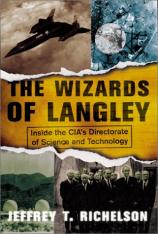The Wizards of Langley: Inside the Cia's Directorate of Science and Technology
Review
The Wizards of Langley: Inside the Cia's Directorate of Science and Technology
There is certainly a fascinating book (or books) to be written
about the Central Intelligence Agency's work in satellite
technology, photo reconnaissance, eavesdropping, clandestine spying
and other such spooky subjects --- but THE WIZARDS OF LANGLEY is
not it.
Author Jeffrey T. Richelson's credentials are solid. He has a Ph.D.
in political science, is a senior fellow at the National Security
Archive in Washington and has written several other books on the
same general subject. But here he has produced a book that makes a
potentially fascinating subject seem dull indeed.
Perhaps Richelson is actually too close to his subject. He seems
endlessly fascinated with the arcane turf wars and jurisdictional
disputes between the CIA and the military, or within the CIA
bureaucracy itself, that have raged almost since the day the agency
was created in 1962. This becomes a dominant theme of his book,
getting in the way of his account of the agency's work. It is the
sort of thing that might be of passing interest only to those whose
careers were directly involved; to the lay reader interested in CIA
matters, it just creates a wasteland of flat and pretty much
irrelevant detail.
Richelson tries gamely to animate his account, but his prose is
hardly inspired. Despite his efforts, the people involved seldom
become rounded human beings. They seem merely pawns in the
bureaucratic chess game that so fascinates him. And his pages are
overrun with that besetting sin of so many books on military
matters, a bewildering mass of acronyms that infest the book like
literary crabgrass in which the reader quickly feels trapped.
Richelson seems aware of this problem, for he has provided an
appendix listing 137 different acronyms --- though missing from
that list is my personal favorite: Possible Nuclear Underground
Test Site (PNUTS). If a name is needed for this addiction of the
military (and of government in general) to alphabetic
abbreviations, may I propose "acronymphomania?"
Another problem, perhaps unavoidable but no less annoying, is the
book's emphasis, at the expense of narrative flow, on technical
details of the various satellites, space cameras, and other devices
developed by and for the CIA. More inside baseball for the initiate
rather than compelling storytelling for the general reader.
The book is not, to be sure, a total loss. Occasional episodes stir
briefly to life --- the complex maneuverings needed to spirit six
Americans out of Iran at the height of the 1980-81 hostage crisis;
accounts of three or four agency employees who betrayed secrets to
other countries; entertainingly loony accounts of CIA attempts to
make spies out of cats, birds, and human psychics (one cat, wired
to the max with eavesdropping gear, was taken out on a Washington
street for a test run and promptly run over by a passing taxi). And
there are a few felicitous turns of phrase, such as Richelson's
reference to legendary "Area 51" in the Nevada desert, a spot so
beloved by UFO hobbyists, as "the world's most famous top-secret
base."
Richelson has been conscientious to a fault. His 50 pages of source
notes and vast bibliography show the thoroughness of his research,
but the resulting book simply does not make his subject very
interesting.
Reviewed by Robert Finn (Robertfinn@aol.com) on January 24, 2011
The Wizards of Langley: Inside the Cia's Directorate of Science and Technology
- Publication Date: August 14, 2001
- Genres: Nonfiction
- Hardcover: 416 pages
- Publisher: Basic Books
- ISBN-10: 0813366992
- ISBN-13: 9780813366999




